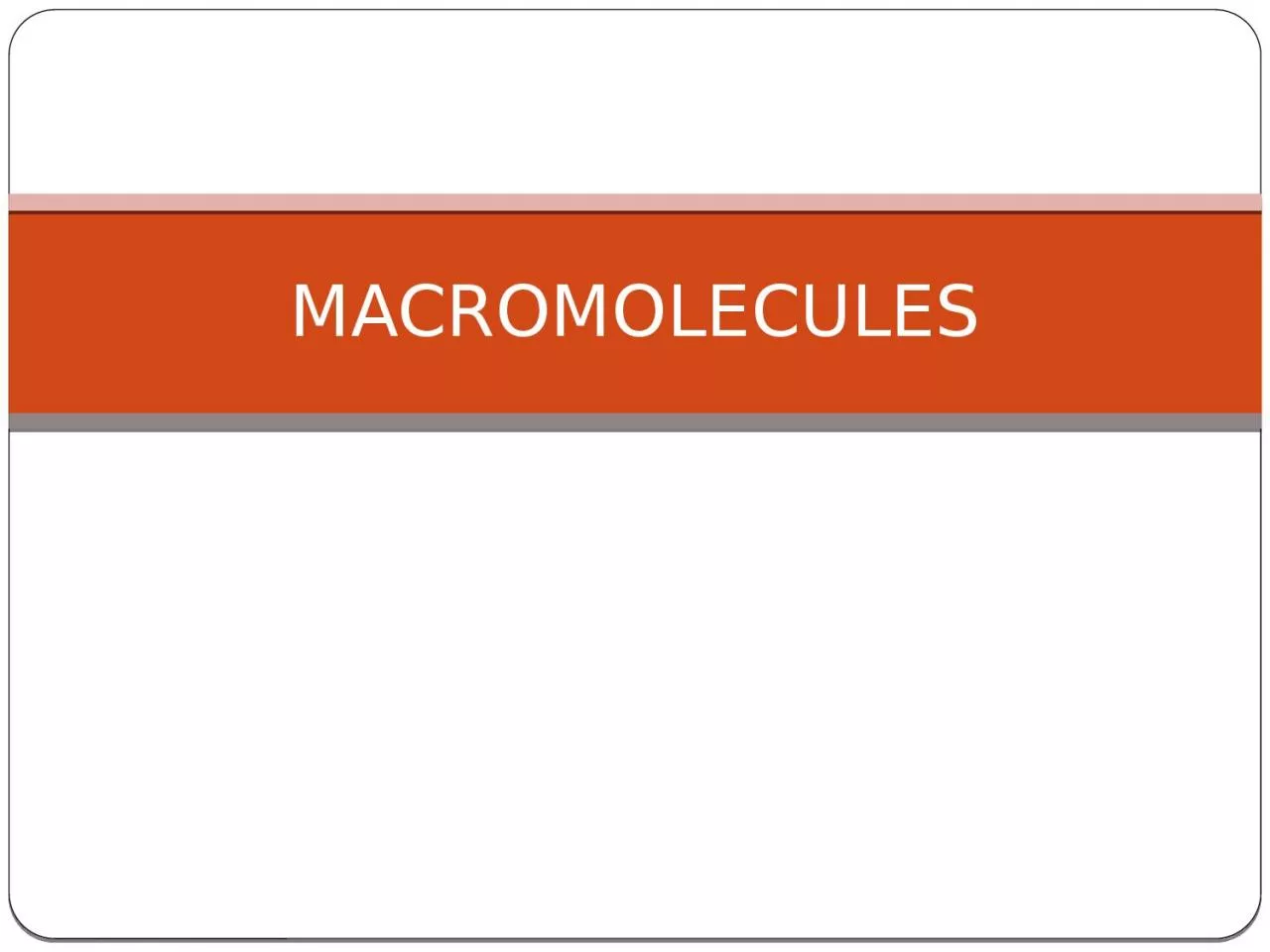

Metabolism is the sum of all biological processes There are 2 major metabolic processes Anabolism the building up of complex molecules Catabolism the breaking down of complex molecules Macromolecules ID: 1034793
Download Presentation The PPT/PDF document "MACROMOLECULES Metabolic Processes" is the property of its rightful owner. Permission is granted to download and print the materials on this web site for personal, non-commercial use only, and to display it on your personal computer provided you do not modify the materials and that you retain all copyright notices contained in the materials. By downloading content from our website, you accept the terms of this agreement.
1. MACROMOLECULES
2. Metabolic ProcessesMetabolism is the sum of all biological processes. There are 2 major metabolic processesAnabolism – the building up of complex moleculesCatabolism – the breaking down of complex molecules
3. MacromoleculesLarge organic molecules (made of carbon)Known as polymers Made up of smaller “building blocks” – monomersFormed through a process known as dehydration synthesisForms polymers by combining monomers by removing waterSeparated through a process known as hydrolysis Monomers are separated through the addition of water
4. 4 Major Types of MacromoleculesCarbohydratesLipidsProteinsNucleic Acids
5. After watching the video, with your partner, identify 2 examples of carbohydrates?
6. CarbohydratesSugar molecules (ranging from small sugars to large sugars)Have the molecular formula (CH2O)n
7. CarbohydratesMonomers – monosaccharides: a single sugar unitPolymers – disaccharides (two sugar units) and polysaccharides (many sugar units)glucoseglucoseglucoseglucoseglucoseglucoseglucoseglucoseglucosecellulose
8. Carbohydrate - FunctionMain source of energy for the bodyProvide short term energy – will be used up in short periods of timeStructure/Support – make up the cell wall in plants Examples: Starch, glucose, cellulose
9. Check for Understanding: With your partner, identify the following as polymers or monomers.
10. LipidsCompounds that are not soluble in waterGeneral structure of a lipdSaturdated fatty acids – have single C-C bondsUnsaturated fatty acids – have at least 1 double C-C bond
11. LipidsMonors – triglyceridesMade up of 1 glycerol and 3 fatty acidsNo polymers HH-C----OH-C----OH-C----O HglycerolOC-CH2-CH2-CH2-CH2-CH2-CH2-CH2-CH2-CH2-CH3=fatty acidsOC-CH2-CH2-CH2-CH2-CH2-CH2-CH2-CH2-CH2-CH3=OC-CH2-CH2-CH2-CH=CH-CH2-CH2-CH2-CH2-CH3=
12. Lipids - functionsLong term energy storageProtection against heat lossMajor component of membranes (phospholipids)Examples: cholesterol, oils, waxes
13. Check for Understanding: With your partner, label the fatty acids below as either saturated or unsaturated.
14. Proteins Polypeptide chains made from amino acidsHave a 3 dimensional globular shapeAmino acids are made of carbon, hydrogen, amino group, carboxyl acid, variable R group
15. ProteinsMonomer – amino acids2 types of amino acidsEssential – cannot be made by the body (need to be consumed)Non-essential – can be made by the bodyPolymer – polypeptide chain
16. Proteins - functionStorageTransport of materialsMovement: musclesEnzymes: aid in cellular reactionsDefense: antibodies (defend your body from infections)Examples: enzymes, hormones
17. With your partner, place a star next to each of the structures below that is an amino acid and tell me why.
18. Nucleic AcidsCompounds that are made up of nucleotides OO=P-O OPhosphate GroupNNitrogenous base (A, G, C, or T)CH2OC1C4C3C25 Sugar(deoxyribose)
19. Nucleic AcidsMonomers – nucleotidesPolymer – DNA/RNADNA – deoxyribonucleic acidGenetic materialCodes for proteinsRNA – ribonucleic acidReads the DNAMakes proteins
20. Nucleic Acids - FunctionStore genetic informationTransmit heredityExamples: DNA & RNA
21. Check for Understanding:With your partner, place a star next to each of the structures below that represent the nitrogenous base component of a nucleotide. Be sure to include why.